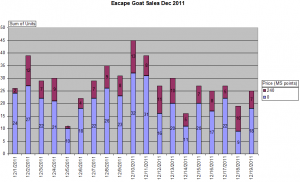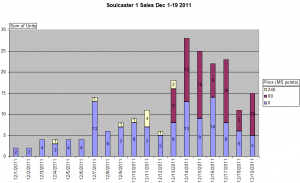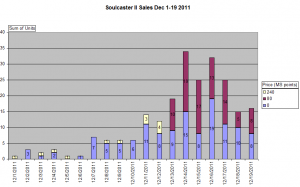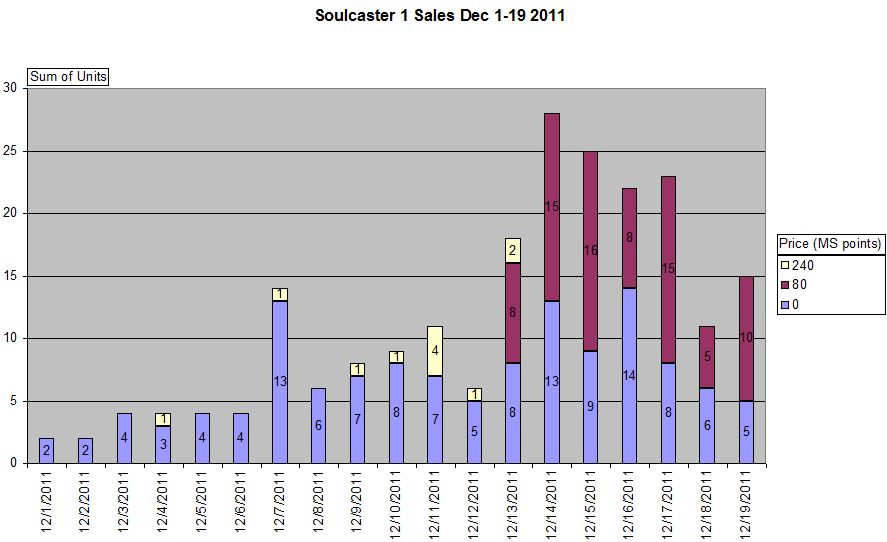One week ago, on December 13, I dropped the prices of my first two games, Soulcaster and Soulcaster II, to coincide with an article I wrote for IndieGamerChick (later picked up by Gamasutra). The short story is that Escape Goat wasn’t selling as well as I hoped, and my hypothesis was that it was because it was priced at 240 MSP instead of 80 MSP. The sales figures are finally in, so I can report what’s happened so far.
Bottom line: the price drop resulted in a staggering increase in revenue. Let’s take a closer look, starting with how things were selling in November to establish a baseline.
November 1-30 2011 Sales (30 days):
| Game |
Trials |
Sales |
Conversion |
Daily Net |
| Soulcaster |
115 |
39 |
34% |
$2.73 |
| Soulcaster II |
76 |
18 |
23% |
$1.26 |
| Escape Goat* |
2686 |
515 |
19% |
$37.29 |
*Escape Goat has much stronger numbers because November was its release month. Take a look at how the daily revenue has tapered off in its second month:
As you can see, the revenue from the Soulcaster games was barely covering my rent at the coffee shop. So let’s see what happened in the week since the price drop:
December 13-19 2011 Sales (7 days):
| Game |
Trials |
Sales |
Conversion |
Daily Net |
Net Change |
| Soulcaster |
63 |
142 |
225% |
$14.20 |
+520% |
| Soulcaster II |
80 |
86 |
107% |
$8.60 |
+680% |
| Escape Goat |
117 |
52 |
44% |
$15.60 |
-237% |
The numbers speak for themselves. I also brought in some charts to give this post a bit more visual impact:
Escape Goat:

Soulcaster:

Soulcaster II:

The most shocking stat for me is the conversion rate. For both games it jumped above 100%. This means more people are buying the full version than are trying the demo first. One explanation for this is that fans of one game buy the second one sight-unseen, perhaps through the new “related games” links. The games are similar enough that if you like one, you’ll probably like the other. But outside of those purchases, I think it really speaks to the power of the 80 MSP in terms of impulse buying. Customers are grabbing the full version without trying it out first, because, “hey, it’s only 80 MSP.”
Edit: As pointed out to me by Ben Kane, Alex Macfarlane Smith, and Paul Thomas, the “over 100%” conversion might be from customers who had previously downloaded the trial, rather than trying the game on the purchase date. Thanks guys for noting this.
I know, it’s early to call. Just one week of data, and who knows, it could all collapse over the next couple weeks. Maybe a chunk of these sales are the result of the publicity my price drop got. To know for sure, we’ll just have to wait.
To summarize:
- After dropping the price, sales went up 12-fold, driving daily revenue up five-fold.
- I’m making nearly as much off Soulcaster, a game that’s been out over 20 months, as I am off Escape Goat, which is only in its second month and should be in its prime for sales.
- The dashboard update seemed to have little effect, since it went into effect a few days before the price drop. And notice how it did not impact the sales or downloads of Escape Goat.
I’ll post another update after some more figures come in. But so far, 80 MSP seems like the right price for these games. It’s great to be making money with them again. I can’t wait until February when I can drop the price on Escape Goat as well.



